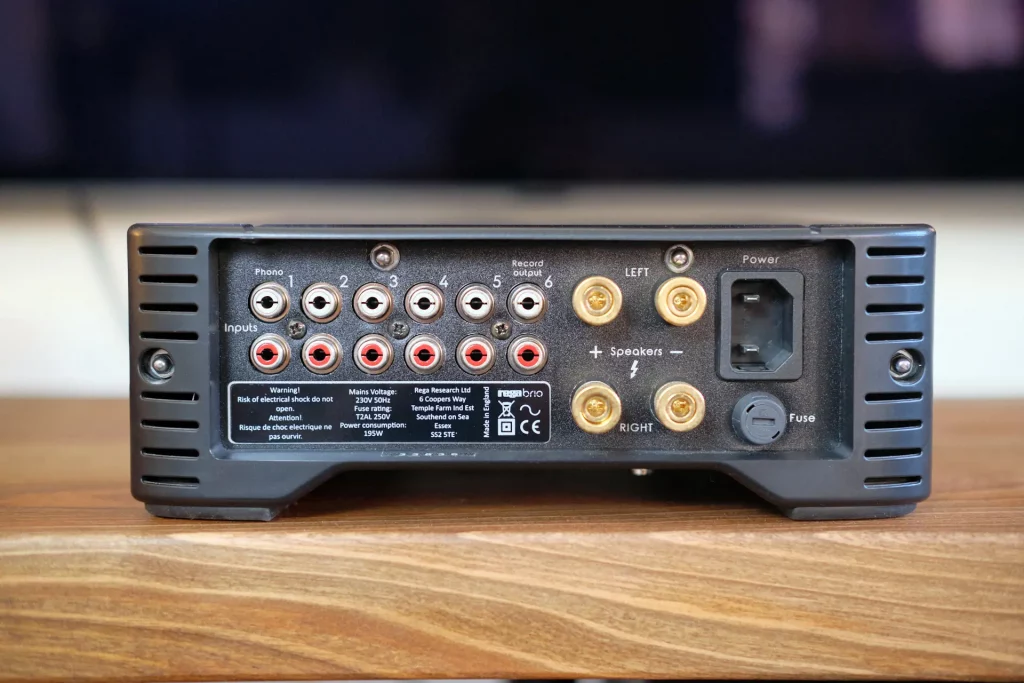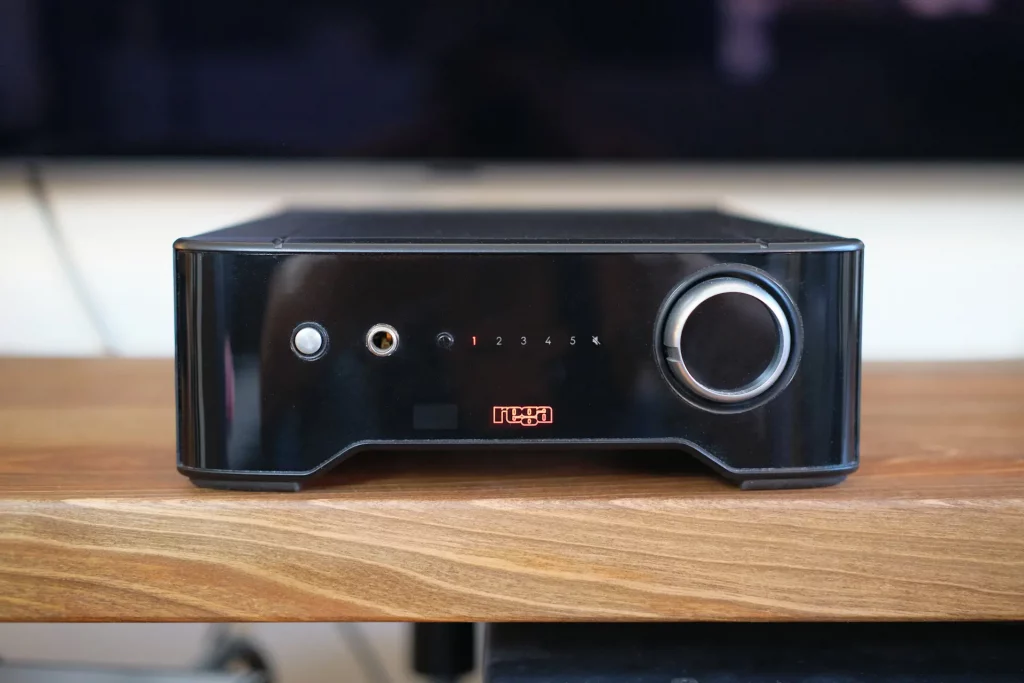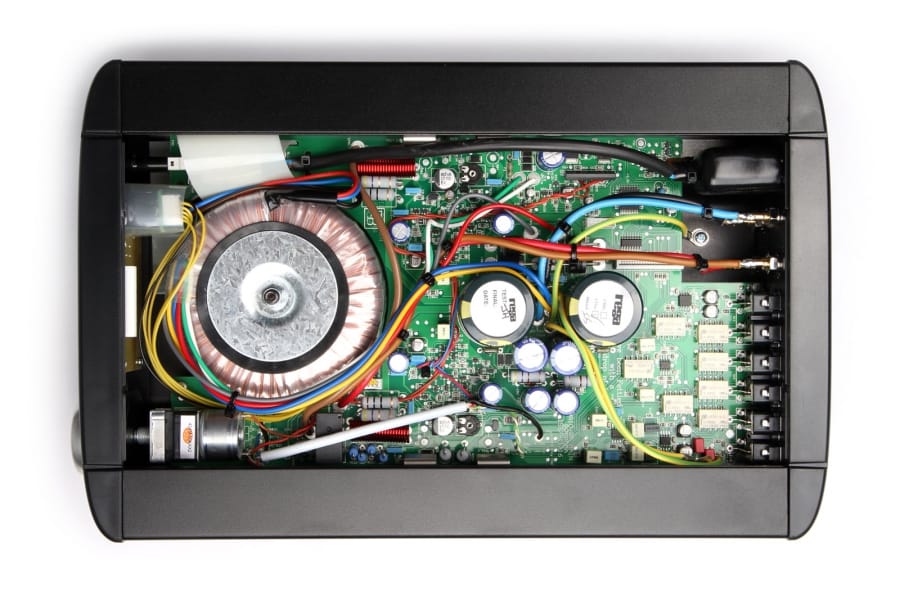My experience with Rega amps is very limited so I welcomed a chance to review Rega Brio in my own setup. For those unfamiliar with it, the Brio amp has been continually praised by big mainstream media with What-HiFi leading the way. So let’s see if we see eye to eye on this.
Build and Connectivity
Rega Brio is a good old integrated amplifier with a bunch of analog inputs but without a digital section whatsoever. For those of you looking for an all-in-one solution, this might be offputting, but there’s nothing inherently wrong with keeping things simple and analog-only. If you look at the back of the unit, you’ll find six pairs of RCA connectors. One of those is a phono input for a turntable, four are just your usual line-level inputs for DACs, CD players, and other line-level external sources. The last one is a record output, that rarely anybody I know ever used, but it’s here if you ever need it. As for the speaker outputs, you’ll find a set of sturdy-looking binding posts.


In the front of the unit, you’ll find a headphone output too. Next to it sits the input selector and finally a big volume knob. The whole unit feels sturdy enough with a mix of metal and decent-quality plastics. At 5.1 kg of weight, it’s more than enough to hold its ground if you connect heavy audiophile cables to its back. Given the small size of the amp, this number actually feels heftier than you’d expect by just reading it. Talking about the small size, Brio comes in a shoebox form factor, which is half the width of the full-size HiFi component and a very popular size among British HiFi makers. Sure, some class D amps are even smaller nowadays, but I don’t think that anybody will have a problem finding space for this one.
Features
Going by its size, you might have thought that Rega Brio is a class D amplifier. You would be wrong because it is a typical class AB design, the one most of us grew up with. A great compromise and middle ground between highly efficient class D and very inefficient class A. It’s rated at 50 Watts per channel into 8 Ohms, and one look inside reveals a big toroidal transformer and a pair of Samwha audio capacitors that will ensure what’s promised. While open, you can notice a good-quality motorized ALPS volume potentiometer too.

Testing
I hooked Rega Brio to several different DACs acting as a line-level source, ranging from a very nice SMSL M500 MKII to a great Gustard R26. It was powering three different speakers: Triangle Borea BR03, KEF LS50, and my own champion Spirit Wind. Using all of these combinations gave me a pretty clear picture of what Rega Brio is all about.
Sound
Rega Brio is all about full and juicy sound first, and detail retrieval second. Let me elaborate on that a bit better. Brio’s tonality definitely leans toward warm with the full bassline that lends padding to the upper notes too. That’s why notes in the midbass region sound very thick, and the same is very much true for the midrange. Anything you could describe as thin or harsh is completely absent from the sound of the Brio amp. The highest frequencies are clean but once again quite sweet and on the tamer side of things. All these joined together to make a full, juicy, and slightly darker tonal character. The beauty of this amp is that it can do that while managing to sound clean and well-organized too. Lesser amps with similar tonal tuning tend to blend tones together and make everything feel blanketed – that never happens with Rega Brio. True, this is not the fastest and most precise amplifier in the world, but it doesn’t feel sluggish or lacking precision either. Those full-bodied notes move along with a very decent pace and timing, with leading edges that are clean and quite energetic.
Rega Brio handles dynamics in a very decent manner too. It can’t really deliver huge dynamic swings because it’s not a powerhouse, but it sounds quite alive and punchy. Nobody would ever cause this amp of sounding flat and lifeless, that’s for sure. Now when you put this dynamic eagerness and full tonality together, Rega Brio really does sound bold.
Finally, let’s talk about soundstaging. Rega Brio separates instruments quite well and puts them inside the modestly sized but well-arranged soundstage. Leading vocals and instruments sound bold, forward in the mix, and present. I actually enjoyed listening to my favorite male and female vocals true this amp as they always sounded full and chesty. On the other hand, that sweet and somewhat tame highest part of the spectrum doesn’t do much in terms of overall spaciousness and airiness. If you’re all about the big and breezy soundstage, you’ll probably be better off looking elsewhere. And that leads us to a few comparisons.

Comparisons
NAD D 3020 V2 is the first on the list for one simple reason. These two amps share the overall sound philosophy and tonality. Features and practical differences aside these amps favor full and bold tones over sharp edges. That said, the price difference is clearly reflected in their performance. Nad D 3020 V2 can’t separate tones and make them sound as clean and delineated. Instead, they feel more congested and grouped under one shared blanket of warmth. Also, NAD is not as punchy and lively when it comes to dynamics. Rega Brio does the same kind of tonality but with clearly greater skill, everything feels improved compared to NAD – clarity, separation, dynamics, and soundstaging.
SMSL A300, SMSL DA-9, and Topping PA5 are all more affordable class D amps coming from China. These can all extract similar amounts of details, maybe even more if we’re talking about the highest frequencies. But next to Brio, all of these will sound tonally and dynamically flat, cold, and analytical. Some people will prefer that for sure, but I believe that most listeners would easily choose Brio in a direct comparison. I know I would because it adds a bit of fat, boldness, and energy in all the right places.
Atoll IN100 costs roughly 50% more, it’s bigger, better made, and more powerful. Tonally speaking, Atoll is noticeably brighter and some care with matching is needed. Gear that matches well with Brio will probably not match well with IN100 and vice versa. That said, IN100 digs deeper into the bassline and maintains a firmer grip over the bass notes at all times. The same is true for a tighter and well-behaved midbass section too. In a direct comparison, Rega Brio almost feels bloated in this region. But unlike the previously mentioned affordable class D amps, Atoll has a great deal of dynamic swing and authority which prevent it from ever sounding flat or lacking energy.
Moving to the upper frequencies, Atoll can retrieve more details and offer faster transients. The hi-end extension is also noticeably better and IN100 projects a wider and deeper soundstage with more air. All in all, I find Atoll IN100 to be a more capable amp of the two but some care with matching is needed to avoid excessive brightness and sharpness.
Conclusion
Rega Brio is not the most revealing and the fastest-sounding amp. It prioritizes warm and full-bodied tonal balance and it does that with great skill. It’s a noticeable upgrade from similarly tuned but more affordable amplifiers such as NAD used in the comparison. It’s also a noticeably different sound from what you would get with a modern class D amp of a similar price. While those lean heavily on technicalities, Brio leans on humane and soulful tuning that won’t suit everyone’s taste but will make those who seek those qualities very happy.
| REGA BRIO – CHARACTERISTICS |
|
Power Output: 50 W into 8 Ω |






Very good! The blog demystified the essence of amplifiers perfectly.